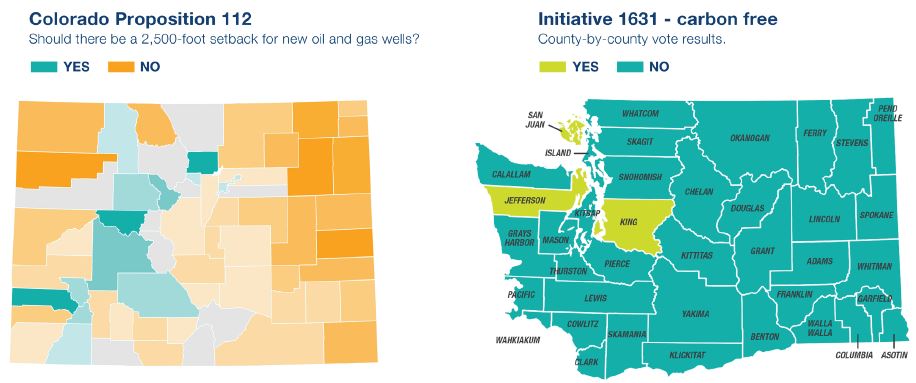
The Energy Edge: What Colorado’s and Washington’s Pro-Energy Votes Could Mean for the Rest of the Industry
Earlier this month, voters in Colorado rejected measures that would have made it more difficult for energy companies to thrive in the state, while voters in the state of Washington rejected a game-changing carbon fee on emissions.
In Colorado, voters said no to Proposition 112, the initiative that would have dramatically limited the use of hydraulic fracturing. This essentially maintains the current status quo in the state. Additionally, Coloradans struck down Amendment 74, which would have allowed property owners to seek compensation from the government any time a government action or regulation reduced the value of their property. The amendment needed 55 percent of the vote to become law and received less than 47 percent.¹
Meanwhile in Washington, voters said no to Initiative 1631, the proposed carbon fee on fossil-fuel emissions. The tax-like fee would’ve taken effect in 2020 and been the first of its kind in the U.S.²
Voters in Colorado and Washington Reject Measures Challenging the Oil & Gas Industry
What's the Point?
Energy companies shelled out to ensure neither of these provisions passed. Some estimates say the oil and gas industry spent in excess of $31 million on ads and other materials in Washington² and up to $41 million in Colorado³ to convince voters to reject these measures. While much attention has been focused on the industry spend, they weren’t alone. On the other side, proponents of Washington’s carbon fee spent around $15 million in support of the initiative. Colorado Rising, the committee supporting its state’s measure, was able to raise about $819,000 on the backs of individuals and environmental advocacy groups.
The proposed carbon fee may have cost the oil and gas industry $1 billion annually by 2023. Opponents of Initiative 1631 said it would’ve led to soaring gas prices as energy companies would need to find that lost revenue in the pockets of regular energy users. Meanwhile in Colorado, if Prop 112 passed, it may have eliminated tens of thousands of jobs and hundreds of millions in tax revenue for the state. Voters recognized and grabbed onto these messages as their reason for saying no on their ballots.
Why Should I Care?
Just because these measures failed doesn’t mean the fight is over for oil and gas companies. Far from it, actually.
Beyond Colorado and Washington, other emissions-focused measures were voted on in states across the country, including Nevada, Arizona and California. After this most recent vote, Washington has now seen energy-related votes in two consecutive elections.
Following the recent vote, Yes On 1631 in Washington released a statement that said they and others are not giving up. “The issue is not going away, and neither are we. We stand ready to fight in next year’s legislature and beyond.”4
Though it’s early, East Coast lawmakers in states like Connecticut, Maryland, Massachusetts, New Jersey, New York, Pennsylvania, Rhode Island and Vermont may introduce their own carbon-pricing legislation in the near future.5 And of course, Washington isn’t quite ready to give up yet either. At some point, Congress may need to step in and provide some nationwide clarity for the industry in the form of regulation. But with a split Congress and a president who has pulled back regulation since entering office, any action may be two years away.
If this year’s ballot battles are any indication, the industry will need to prepare for a long-term fight to keep these measures from passing across the nation.
For more cutting-edge perspectives on the most compelling news, facts and figures impacting the U.S. energy industry, read other editions of The Energy Edge.
- https://www.denverpost.com/2018/11/06/colorado-proposition-112-results/
- https://www.seattletimes.com/seattle-news/politics/voters-rejecting-carbon-fee-in-first-day-returns/
- https://www.bizjournals.com/denver/news/2018/11/06/colorado-prop-112-defeated.html
- https://www.facebook.com/yeson1631/
- https://www.reuters.com/article/us-usa-election-carbontax-analysis/after-defeat-in-west-u-s-carbon-tax-push-looks-east-idUSKCN1ND1PT



